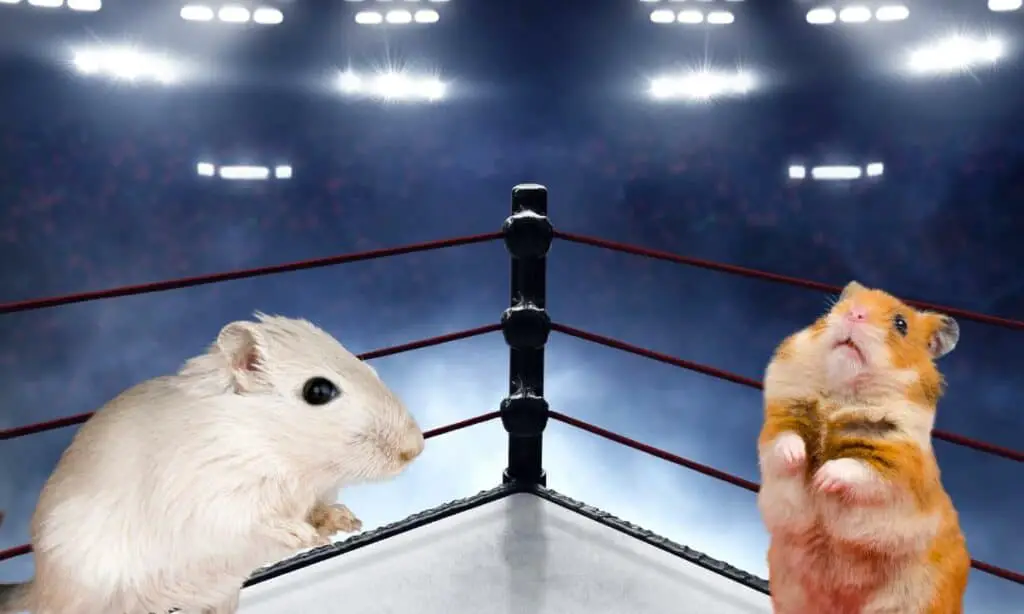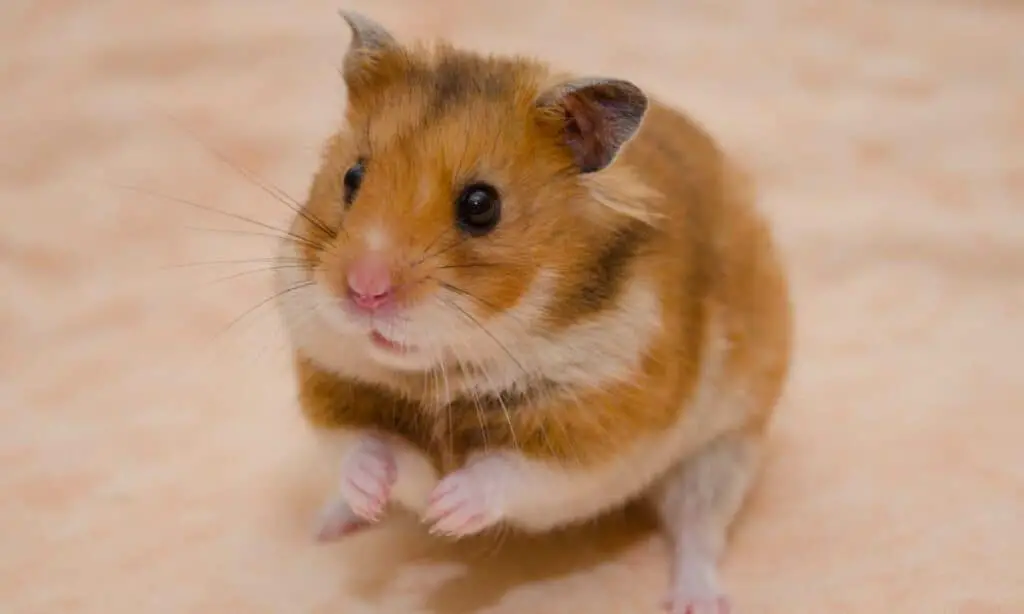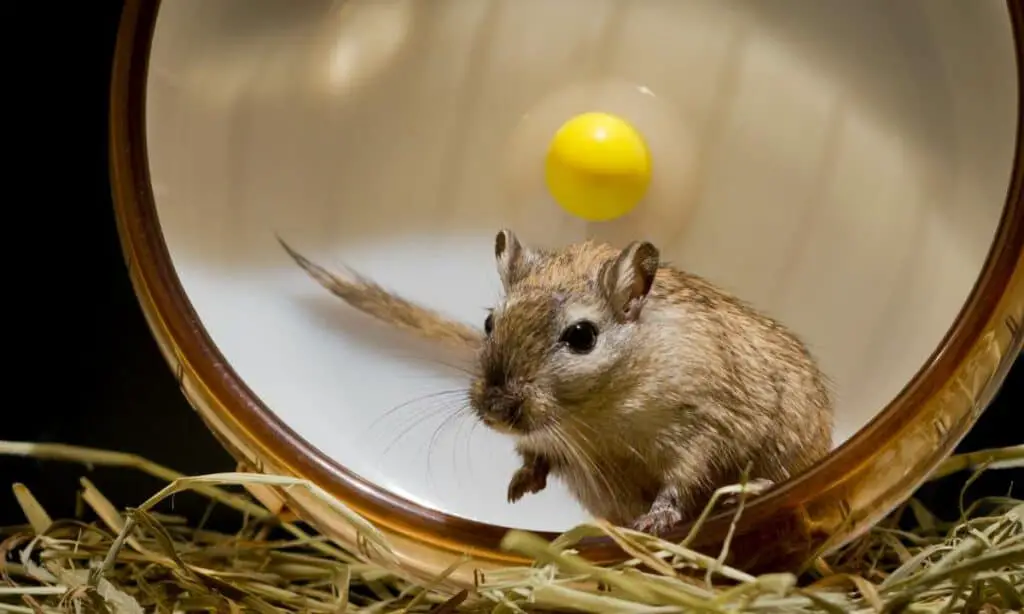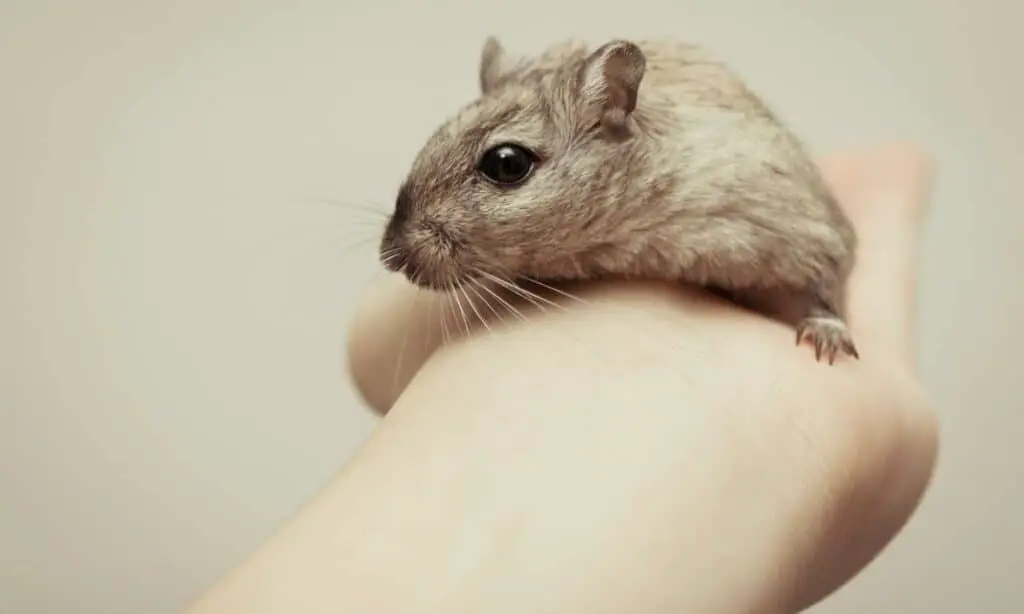Gerbils vs. hamsters: the epic battle of pocket-sized cuteness! Have you ever found yourself pondering which adorable creature would make the perfect furry companion?
Well, fear not, for we’ve got the answer you’ve been searching for!
Comparing gerbils and hamsters in captivity, gerbils stand out as more docile and less prone to biting. While hamsters can be tamed through regular handling, they’re less tolerant of prolonged holding and may bite if frightened or mishandled.
Table of Contents
Hamsters vs. Gerbils: Understanding the Differences
Gerbils and hamsters are both small rodents popularly kept as pets, yet they differ in several aspects
The most obvious differences between gerbils and hamsters lie in their size and shape.
Gerbils typically measure between 5 to 9 inches (13-22cm) long while hamsters only reach a maximum of 7 inches (18cm).
Hamsters also have rounder bodies with much shorter hind legs, whereas gerbils have an elongated look with longer hind legs that allow them to stand on their hind legs more easily.
One of the most distinguishing features is the snout size of both rodents.
Hamsters have larger snouts compared to gerbils which can be used for burrowing and digging activities.
Gerbils tend to have longer tails which are almost double the length of a hamster’s tail at roughly 6-8 inches (15-20 cm).
Another major difference between gerbils and hamsters is behavior. While both enjoy playing with wheels, tunnels, and toys, each species does it differently due to their varying physiology.
Hamsters can curl up into a ball when sleeping or threatened while gerbils will freeze or run away when startled or alarmed.
This behavior stems from hamsters lacking the mobility of their longer-limbed relatives. This limitation gives hamsters an advantage in evading predators. Conversely, gerbils often choose flight over fight when faced with danger
From physical attributes like size and snout length to behavioral traits, gerbils and hamsters showcase a variety of differences
With this guide, you’re now equipped to distinguish between these two fascinating rodents with ease

Hamsters vs. Gerbils as Pets
Hamsters and gerbils are popular small pets known for bringing joy to their owners.
Despite their similar appearances, several distinct differences set these two species apart.
Gerbils are part of the Gerbillinae subfamily within the Muridae family. Worldwide, there are over 110 different species of gerbils.
The most common variety kept as a pet is the Mongolian gerbil.
They are diurnal, meaning they are most active during the day and have a lifespan of 2-6 years.
Gerbils make great pets due to their gentle nature and unique personalities.
Syrian hamsters, also known as golden hamsters or teddy bear hamsters, belong to one of several species from within the genus Mesocricetus and have been kept as pets since 1939.
Hamsters are nocturnal, most active at night.
They have a lifespan of up to two years in captivity. However, they don’t socialize well with other hamsters or gerbils. If considering two pets, it’s advised not to mix these species
While hamsters need more daily care and larger cages than gerbils, they might not be the ideal choice for everyone.
When choosing between a hamster or a gerbil, remember that each breed has its own needs. Both make excellent companions, but thorough research is essential before adoption.
Can Gerbils and Hamsters Play Together?
Hamsters and gerbils make great pets, but many people wonder whether or not these two species can play together.
While both hamsters and gerbils are small rodents, they are actually different species.
Hamsters are solitary animals that can be territorial over their environment, while gerbils prefer to live in pairs and do well with other gerbils of the same breed.
Therefore, it’s not advised to place a hamster and gerbil together in the same enclosure as it could lead to either pet feeling threatened by the other’s presence.
It is possible for a hamster to live with other smaller animals such as mice or dwarf hamsters, but introducing them can be challenging.
Due to aggressive behavior potential, it’s important to plan out any introductions carefully so that neither species feels threatened by the presence of the other.
When introducing two different kinds of rodents, you should always keep an eye out for any signs of stress or aggression so that you can take immediate action if there is a problem.
In order to create an environment that’s both safe and enjoyable for both gerbils and hamsters, it’s best to provide each pet with their own enclosure or cage with plenty of hiding spots and toys inside that allow them each the space they need for their own safety and comfort.
With careful monitoring and some extra precautions when introducing new pets into your home, both hamsters and gerbils can still enjoy playing in your home despite being from different species!
Are Gerbils or Hamsters Bigger?
Many people ask, “Which is bigger—gerbils or hamsters?”
The answer depends on the type of gerbil or hamster in question. Generally speaking, most gerbils are a bit bigger than hamsters – the average gerbil grows to 2-3 inches long while most dwarf hamsters max out at 1-2 inches.
That said, there are larger varieties of both species – some dwarf hamsters can grow up to 3 inches long and some species of gerbils can reach 4-7 inches!
Mongolian gerbils and dwarf hamsters are the two main types found in pet stores and they differ in several ways.
Gerbils have slim bodies, small heads, and big hind legs— perfect for their natural preference for burrowing.
Hamsters, on the other hand, tend to be rounder with a large head and their active front legs provide them with more agility for climbing.
In terms of size, mature adults of both species typically weigh between 40-50g (1.4-1.8 oz).
Plus, when fully grown most adult dwarf and Syrian hamster breeds don’t get any bigger than about 5 inches long (though their longer tails add length).
Gerbils also have noticeably longer tails than their hamster counterparts which can range from 2 to 8 inches depending on the breed.
Tail length variations are not always reliable indicators of whether you have a Dwarf Hamster or Mongolian Gerbil as tail lengths between different individuals may vary greatly due to environmental factors and individual genetics.
The best way to determine which animal you have is to research both breeds and compare them against one another before making a decision.

Are Gerbils or Hamsters Friendlier?
When making the decision to bring a small pet into your home, it is important to consider how friendly the animal is.
When it comes to hamsters and gerbils, both can make wonderful pets for those wanting affectionate companionship.
While both animals are small rodents that enjoy burrowing and sleeping during the day, there are a few key differences when it comes to their personalities.
Gerbils are known for being highly friendly and social animals that generally enjoy interacting with humans.
They are curious by nature and love playing with the toys you provide them in their cages.
Hamsters, on the other hand, can be quite shy and may take some time before they become comfortable around people.
They tend to have more of an independent streak than gerbils do, which can make them harder to bond with initially.
In terms of activity levels, gerbils often tend to be more active than hamsters – they usually like running around their cage while making chirping noises!
Hamsters may not move as frequently or quickly as gerbils do but they still can explore their environment given a chance.
Choosing between a hamster or a gerbil really boils down to personal preference; both species have different personalities that need to be taken into account when making your decision.
Be sure to research each one before welcoming either a gerbil or a hamster into your home!
Do Gerbils or Hamsters Cost More?
Hamsters and gerbils are both small rodents, but they come from different species, and there are some distinct differences between the two.
As far as the initial cost to purchase a gerbil or a hamster, it’s often more expensive to buy a hamster because of its larger size.
Hamsters can range in price from $10 to $20 while gerbils are often cheaper at around only $2.
It’s important to note that the costs associated with owning either of these pets don’t end with the initial purchase price.
Gerbils may need more specialized care than hamsters due to their active nature and require a larger habitat over time.
Be sure you’re willing and able to financially accommodate the space needs of your gerbil, or opt for a smaller pet such as a hamster if you have limited resources.
Additionally, both hamster and gerbil cages need frequent cleaning which can add up over time in terms of supplies used for litter changes and costs for nest material like wood chips or hay which need replacing regularly.
Don’t forget about any vet bills associated with pet ownership either when budgeting for your new furry friend!
With all this in mind, be sure you’re ready to take on any additional costs before deciding whether a gerbil or hamster is right for you:
Initial purchase price – hamsters cost between $10 to $20 and gerbils cost around only $2.
Space needs – gerbils require a larger habitat over time.
Frequent cleaning – supplies used for litter changes and costs for nest material like wood chips or hay must be replaced regularly.
Vet bills – associated with pet ownership.
Do Gerbils Bite more than Hamsters?
When it comes to the question of which is more likely to bite – hamsters or gerbils – the answer may surprise you.
While both rodents can and do bite when scared or threatened, gerbils are generally considered less likely to bite than hamsters.
The difference between hamsters and gerbils lies in their size, backgrounds, and personalities.
Hamsters are typically larger than gerbils, averaging 6-7 inches long with an average lifespan of two to three years.
Whereas gerbils are typically smaller (3-6 inches long) and have a longer life span (5-7 years).
Also, hamsters are naturally solitary animals while gerbils interact peacefully with other members of their litter and develop social attachments easily.
Hamsters may be more prone to biting due to their size and solitary nature; they may feel threatened when approached or handled by a human that they don’t know well.
Bites from either type of rodent can be quite painful, so it’s always best to take basic safety precautions when handling any type of pet rodent.
Never approach a rodent from above as this can synthesize fear on their part and increase the likelihood of them biting you.
Gerbils and hamsters both make for wonderful little pets with unique personalities that vary greatly between each animal within the species.
Bites from either one should be avoided if possible though, so always use caution around these small furry creatures!

Can Gerbils and Hamsters Live Together?
If you’re looking to have multiple pets in a single household, many people mistakenly believe that hamsters and gerbils can live together as they are both small rodents.
But this is not the case. In fact, it can be dangerous to keep these two species in the same enclosure because they have very different behavioral traits that can create negative consequences when mixed.
Gerbils and hamsters belong to very different rodent branches of the same family tree.
All types of furry little rodents are referred to as “pocket pets,” but gerbils and hamsters cannot coexist due to their varying temperaments and tendencies.
First and foremost, gerbils are social with their own kind whereas Syrian hamsters (the most common type of pet hamster) are territorial loners who can become aggressive if approached by another rodent.
In addition, dwarf hamsters make for poor roommates for both gerbils and other types of dwarfs as they tend to display a lot more aggression than larger breeds do.
Therefore, separate enclosures would be necessary if both a gerbil and a dwarf or Syrian hamster were kept together in the same household.
In conclusion, it’s best not to house multiple rodent species within the same area even if they seem friendly together on first impression.
Some people think that gerbils and dwarf or Syrian Hamsters could cohabitate peacefully in an enclosure, this is not recommended due to their distinct temperaments which can lead to pet injuries or even death amongst these two species when housed near each other.
Do Hamsters or Gerbils Smell More?
Have you ever wondered what the difference is between a hamster and a gerbil?
These two, popular small rodents are often confused with one another. While both hamsters and gerbils are members of the rodent family, there are some key distinguishing features between them.
For example, most pet stores will either sell hamster or gerbil cages and toys, so it is important to know which type of rodent your pet store sells.
But which type of rodent smells more? When deciding whether to get a hamster or a gerbil as a pet, one important factor to consider is the smell.
Mongolian gerbils have an instinctive cleaning behavior that causes them to be less smelly than other animals in their family.
They also tend to urinate very little compared to other rodents like hamsters and they have smaller feces so there is less odor overall.
This means that if you’re looking for a pet that won’t stink up your home then the gerbil may be the better option.
Hamsters can also be pleasant companions although they do not possess the same cleaning habits as Mongolian gerbils and therefore may create more odors in your home than their smaller counterparts.
For this reason, many people find it helpful to keep separate cages for their hamsters and bring out beds for playtime outside of their cabin-style cages.
This can help keep any unpleasant smells from infiltrating your home during cuddles or playtime with your furry friend!
The decision comes down to preference: both types of rodents make wonderful pets as long as they are kept clean and cared for properly!
Are Gerbils or Hamsters More Intelligent?
When considering whether gerbils or hamsters make better pets, one of the most important aspects to consider is their intelligence.
While both animals are considered small pets, there are actually dramatic differences between them when it comes to their levels of intelligence.
Hamsters are primarily solitary animals that thrive on interaction with their owners. When it comes to problem-solving, they have an impressive ability to learn and retain information.
Therefore, hamsters make great interactive pets for those looking for an intelligent companion.
With the right environment and interactions with their owners, these creatures can develop human-like social skills over time.
Although gerbils also demonstrate high levels of intelligence, they aren’t necessarily as interactive as hamsters when it comes to problem-solving or forming relationships with humans.
Nonetheless, they can still possess very admirable cognitive skills and an understanding of their environment that make them satisfying companions when kept in a stimulating environment with plenty of playtime and enriching toys.
In addition, gerbils tend to be less demanding than hamsters when it comes to special dietary requirements or exercise needs.
Overall, both gerbils and hamsters offer distinct advantages that make them each ideal companions in different ways – whether you’re looking for solitary cuddles or an intelligent pet for problem-solving and conversation!

Should I get a gerbil or hamster as a pet for my kid?
If you are considering getting a pet gerbil or hamster for your child, you should consider the differences between the two.
Gerbils are usually more active and enjoy running around furniture, while hamsters like to stay in one spot.
If you get a gerbil, it’s best to get a pair or group as they are social animals and need companionship.
Gerbils also love to burrow and can be seen digging and burrowing in their bedding material.
Hamsters on the other hand like to keep their bedding clean and prefer to sleep in an enclosed space or nest.
Both gerbils and hamsters need plenty of exercise and access to fresh food, water, toys, and safe places to hide.
It comes down to personal preference but both animals make great pets for children.
Do Gerbils Bond With Their Owners Easier Than Hamsters?
Gerbils and hamsters are both popular pet choices, but there’s not much of a comparison when it comes to their ability to bond with their owners.
Gerbils form stronger bonds with people more easily than hamsters do, making them a better choice for those looking for more affectionate pets.
Gerbils are also much easier to handle since they respond well to being picked up and can be trained to come when called. They have an inquisitive nature and often enjoy interacting with people.
Hamsters, on the other hand, often struggle with bonding as they tend to be shy creatures who prefer being left alone in their cages. They can also be difficult to handle due to their fast movements and tendency to bite when scared or stressed.
Therefore, gerbil vs hamster is an easy choice if you’re looking for a pet that will bond with its owner – the gerbil is definitely your best bet!
gerbil vs, there’s not much, popular pet
Are gerbils or hamsters more affectionate?
Gerbils and hamsters are both social creatures, but when it comes to affection, they differ in temperament. Hamsters are generally more reserved and can be kept alone without difficulty.
Despite being social creatures, they tend to live in solitude and do not require much interaction with other hamsters or humans.
On the other hand, gerbils are incredibly sociable and need to live in pairs or groups of approximately four animals. They are far more interactive than hamsters and will often seek out human interaction as well.
Gerbils show a lot of affection towards their owners by climbing on them, licking them, and even grooming them.
They also enjoy playing games like fetch and tug-of-war.
So if you’re looking for an affectionate pet that loves to interact with its owners, then gerbils would make a perfect choice.
Caring for A Gerbil and Hamster. What Do They Need?
Caring for a gerbil and hamster is relatively simple, but requires dedication.
Both require food, water, an enclosure, and regular exercise.
Gerbils need a diet that contains high-quality pellets as well as fresh vegetables such as carrots, apples, and celery.
Hamsters should have access to a variety of foods such as nuts, seeds, fruits, and vegetables. Both animals need clean water available at all times.
An appropriate-sized enclosure will give them the space they need to move around freely and explore their environment.
It should also include bedding material such as shredded paper or wood chips for them to burrow in.
Regular exercise is important for both species; providing them with toys such as wheels or tubes can help keep them active and entertained while providing much-needed physical activity.
With the proper care, both gerbils and hamsters will be happy and healthy companions for years to come!
FAQ
Q: What is the difference between hamsters and gerbils?
A: The key differences between hamsters and gerbils lie in their physical appearances, behaviors, and socialization needs. Hamsters have stubby body shapes and are approximately 4 inches long, while gerbils have long hind legs and are longer in length, typically around 4 to 8 inches. Additionally, hamsters are known to be hoarders, while gerbils love to burrow.
Q: Which is a better pet to get, a hamster or a gerbil?
A: The choice between a hamster and a gerbil as a pet depends on personal preferences and lifestyle. Hamsters are often recommended for individuals or families who want a small pet that requires less socialization. On the other hand, gerbils usually enjoy social interaction and are great for those seeking a more active and interactive pet.
Q: How long do hamsters and gerbils live?
A: On average, hamsters have a shorter lifespan compared to gerbils. Hamsters typically live for about two to five years, while gerbils can live for three to eight years.
Q: What are the main differences in their cage requirements?
A: Hamsters are happy in cages that provide enough space for them to exercise, play, and hoard their food. A hamster cage should have solid walls and a solid floor to prevent them from escaping. On the other hand, gerbils usually require a cage with more floor space and height, as they love to burrow and explore.
Q: Are hamsters and gerbils social animals?
A: Hamsters are mainly solitary animals and are known to be territorial, so they might not get along well with other hamsters. Gerbils, on the other hand, are social animals and it is recommended to keep at least two gerbils together to provide them with proper socialization and companionship.
Q: Can hamsters and gerbils be kept together with other pets?
A: While hamsters and gerbils are generally compatible with other small pets, it’s important to note that interactions between different species should be supervised to ensure their safety. They can be kept separate from guinea pigs or other animals that might see them as prey.
Q: What are some common characteristics of hamsters?
A: Hamsters are small pets that are strictly nocturnal or diurnal, depending on the species. They have tiny claws that need to be trimmed every two weeks. Hamsters are known for their hoarding behavior, and they are often considered an ideal pet for families or individuals who want a low-maintenance and independent companion.
Q: What are some common characteristics of gerbils?
A: Gerbils are small pets that have a longer lifespan compared to hamsters. They are social animals and enjoy living in pairs or small groups. Gerbils are active at night and have a natural instinct to burrow, requiring a cage with suitable bedding and space. They are often considered an ideal pet for those seeking an interactive and energetic companion.
Q: Do hamsters and gerbils have any dietary differences?
A: Hamsters and gerbils have some differences in their dietary requirements. While both can be fed a diet of commercial hamster food, gerbils come from desert regions and may require additional water compared to hamsters. It is important to provide fresh water and a balanced diet suitable for the specific species.
Q: Can hamsters and gerbils be kept as family pets?
A: Both hamsters and gerbils can be kept as family pets, but it is important to consider the needs and behavior of each species. Hamsters are generally less social and may prefer less interaction with children, while gerbils can be more interactive and enjoy playing with their human companions.



